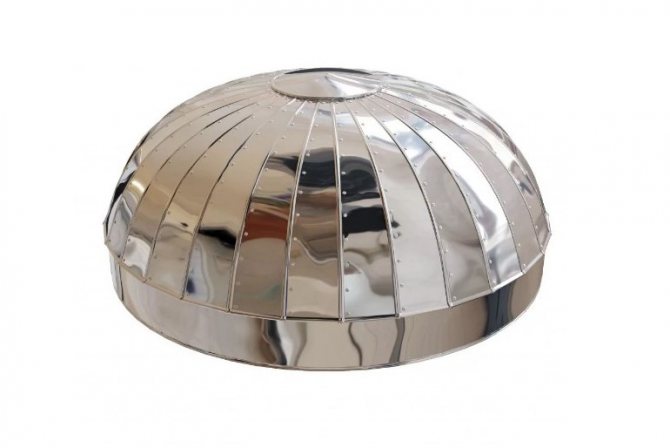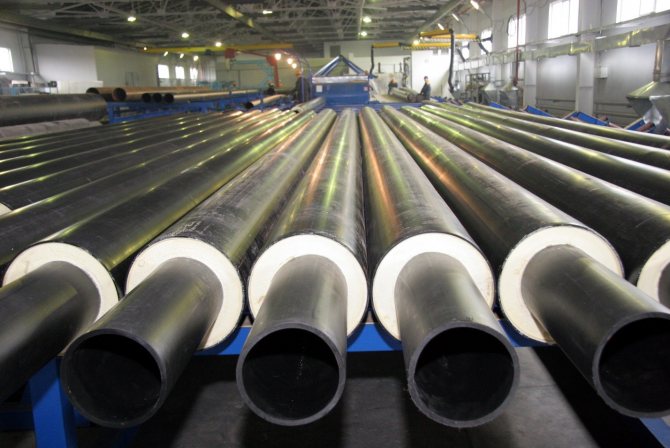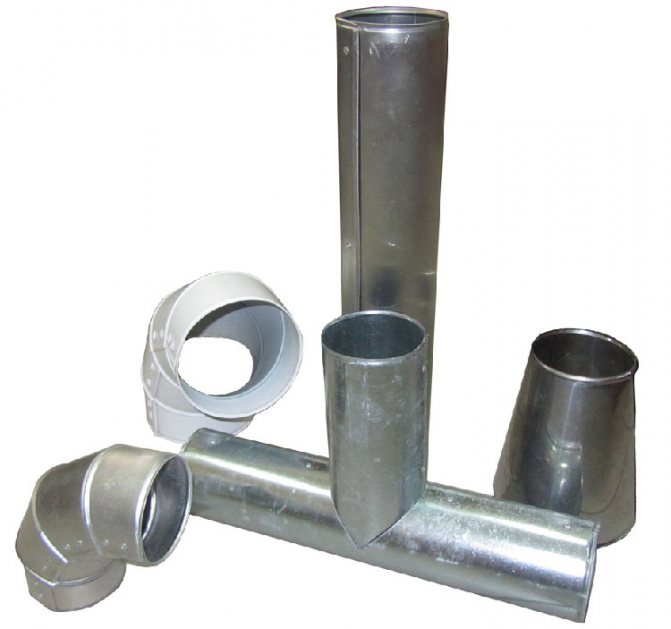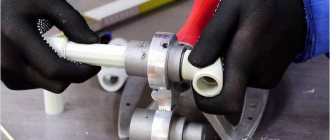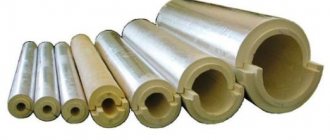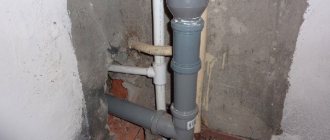Good time of the day, dear reader! Pipelines designed to supply water or heat to a room require high-quality protection against heat losses, mechanical stress and the negative effects of moisture, especially when it comes to their external sections. For these purposes, when assembling highways and wiring of private systems, galvanized pipe insulation is widely used, which effectively prevents the rapid deterioration of thermal insulation on the pipeline, freezing, the appearance of condensate and corrosion formations on its parts.
Why Isolation Is Needed at All
Galvanized steel insulation is a protective coating for the outer surfaces of pipes, which increases their resistance to corrosion, mechanical damage and harmful environmental influences.
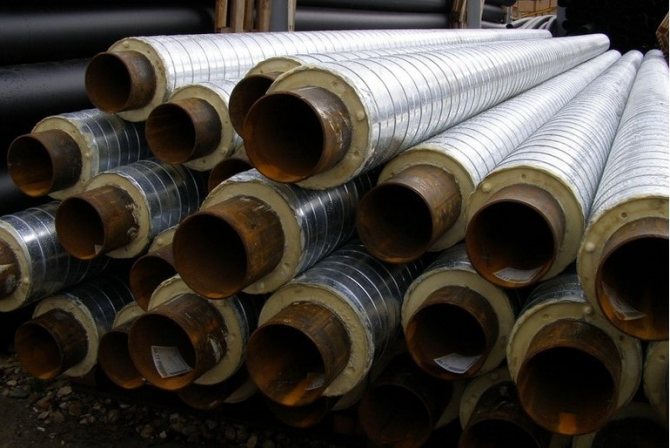
It also gives the structure a more aesthetic appearance, helps to increase the operating temperature range of the transported substance, reduce heat loss and fire hazard.
Protective cover made of aluminum;
The main characteristics include the resistance of aluminum to atmospheric precipitation, and the fact that
The aluminum window retains its appearance unchanged for 25 years. Of the shortcomings, this price is higher than that of a window
made of galvanized steel. Weak resistance to mechanical damage. It is used in the central heating station, heating mains,
boiler rooms, where aesthetics is required over a long service life, in explosive industries, etc.
Sheet thickness from 0.5 mm to 0.8 mm.
What materials are used
This type of insulation is made of galvanized sheet steel in the form of cylinders or shells of different diameters, from which you can choose the right option for any external pipeline.
Installation of galvanized protective shells is carried out on a previously fixed heat-insulating material:
- polyurethane foam. This insulator has a low coefficient of thermal conductivity, hygroscopicity, durability, good adhesion to steel and sheath material, and is applied by spraying. By agreement with the customer, pipes in polyurethane foam insulation (PPU) are equipped with an UEC system (operational remote control). It allows you to obtain real-time information about damage to the steel pipe and shell, the appearance of places of moisture in the heat-insulating layer, disturbances in the operation of the signal wire;
- PPU shell - products made of foamed polyurethane, made in the form of split cylinders, half-cylinders, prefabricated elements. They are fixed on the pipe along the screed;
- polymeric mineral foam. The material has a low coefficient of water absorption, retains heat well in the pipeline. The cost of foamed polymer mineral insulation (PPM) is lower than other options for heat insulators;
- extruded polyethylene. Insulation of pipes with extruded polyethylene is considered to be reinforced (VUS). It is applied at the factory, forms a completely waterproof layer, resistant to temperature extremes and the effects of various chemical compounds and aggressive environments;
- rubber - bituminous mastic. Performs the function of waterproofing metal pipes, without affecting the decrease in their thermal conductivity. The technology of insulation with rubber-bitumen mastic involves the application of several layers: a primer that increases the adhesion of metal surfaces, polymer-bitumen mastic and non-woven fabric for reinforcement. For wrapping the insulated pipe surface, a polymer film or galvanized coating is used.
Pipes in VUS insulation (VUS insulation of bends, pipes)
Among the wide variety of waterproofing for pipe products, the waterproofing for pipes made of extruded polyethylene (VPS) is the most advanced waterproofing.Today it is the VUS and US type extruded polyethylene coating that is the most common coating, surpassing the coating based on tapes, bitumen or other materials in many respects:
- more resistant to external mechanical stress;
- have high adhesion to the pipe surface, as well as a low degree of water permeability and water absorption;
- operation of pipes will be trouble-free for many years (40-50 years);
- such insulation is intended for both underground and underwater laying of pipes with permissible temperature long-term operation from minus 60 ° С to plus 50 ° С;
- provide high contact resistance, guaranteeing high efficiency in cathodic protection.
Purpose of galvanized protective covers
The galvanized casing is a cylindrical product with knurled drainage ribs. It is installed as a protective waterproofing shell on open pipelines with a heat-insulating layer of mineral wool or polyurethane foam shells coated with a waterproofing film.
Also, products are produced in which the outer shell is made of polyethylene.
Requirements for PPU pipes in a galvanized sheath
The durability and trouble-free operation of the pipeline depends on the quality of the materials used in the production. Norms for the production of products in galvanized and PE insulation are regulated by the document GOST 30732-2006... The basic requirements for factories will be as follows:
1. For insulation, it is permissible to use solid polyurethane foam that meets the production standards of GOST. Between the surface of the inner pipe made of black steel and the insulating foam, the adhesion should be as tight as possible (complete adhesion is guaranteed). The degree of adhesion is assessed by testing the shear of the material along the axis: the axial shear is no more than 0.14 MPa at a temperature of +23 degrees.
2. Pipes are made from carbon or low-alloy steel grades of the highest quality. The best option for manufacturing is the longitudinal or seamless method.
3. For external protection, the PPU OTs pipe is covered with thin sheet steel with a wall thickness not exceeding 1 cm. Galvanized class 1 is applied to it (GOST 52246-2004). The OZ casing must be applied in complete tightness.
4. Polyurethane foam in the end section of the product with insulation should have a homogeneous, fine-grained texture. If there are voids in the insulation layer, the size of which exceeds 1/3 of the total thickness of the polyurethane foam, such a product must be rejected.
Requirements, Properties and Specifications of the Coating
In case of open laying of pipelines to protect the thermal insulation of pipes, they are carried out by means of a spirally rolled sheath made of thin sheet galvanized steel of class 1 or 2 (GOST 14918-80), in accordance with the requirements of SNiP 2.0414-88.
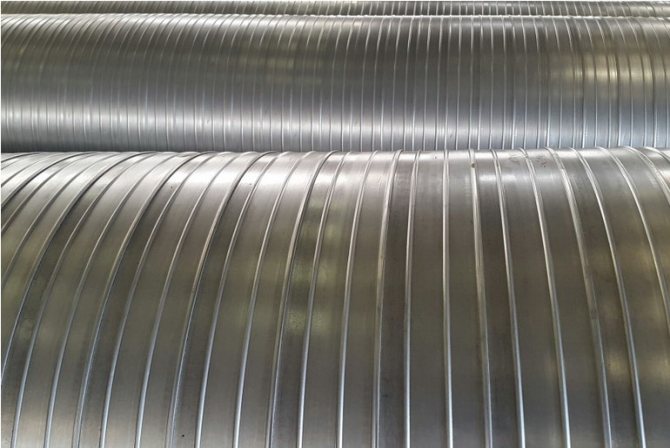

The surface of the shell, according to GOST, on the outside should be perfectly smooth or with insignificant longitudinal stripes and waviness that does not take the pipe wall thickness beyond the permissible limits, on the inside it should be rough. Both surfaces must be free of bubbles, cracks and foreign matter.
Main technical characteristics of products:
- wall thickness - 0.55 - 1.0 mm;
- range of outer diameters - from 100 to 1600 mm;
- length of straight sections - 8-12 m for pipes with a diameter of less than 219 mm and 10-12 m for products with a diameter of 273 mm.
Parameters of manufactured products (VUS insulation)
| Pipe diameter | GOST R51164-98 | GOST 9.602-2005 | GOST 9.602-2016 | |||
| US designs 1 and 2 | US Construction 11 | VUS Design 1 | VUS Construction 2 polypropylene | US Construction 1 and 2 | H Design 14 | |
| Insulation thickness in mm | ||||||
| Ø57 | 2,00 | 1,80 | 2,20 | 2,00 | 1,80 | |
| Ø76 | 2,00 | 1,80 | 2,20 | 2,00 | 1,80 | |
| Ø89 | 2,00 | 1,80 | 2,20 | 2,00 | 1,80 | |
| Ø108 | 2,00 | 1,80 | 2,50 | 2,00 | 1,80 | |
| Ø114 | 2,00 | 1,80 | 2,50 | 2,00 | 1,80 | |
| Ø127 | 2,00 | 2,00 | 2,50 | 2,00 | 2,00 | |
| Ø133 | 2,00 | 2,00 | 2,50 | 2,00 | 2,00 | |
| Ø146 | 2,00 | 2,00 | 2,50 | 2,00 | 2,00 | |
| Ø159 | 2,00 | 2,00 | 2,50 | 2,00 | 2,00 | |
| Ø168 | 2,00 | 2,00 | 2,50 | 2,00 | 2,00 | |
| Ø219 | 2,00 | 2,00 | 2,50 | 2,00 | 2,00 | 2,00 |
| Ø273 | 2,00 | 2,20 | 3,00 | 2,20 | 2,00 | 2,20 |
| Ø325 | 2,20 | 2,20 | 3,00 | 2,20 | 2,20 | 2,20 |
| Ø377 | 2,20 | 2,20 | 3,00 | 2,20 | 2,20 | 2,20 |
| Ø426 | 2,20 | 2,20 | 3,00 | 2,20 | 2,20 | 2,20 |
| Ø530 | 2,20 | 2,20 | 3,50 | 2,50 | 2,20 | 2,20 |
| Ø630 | 2,50 | 2,50 | 3,50 | 2,50 | 2,50 | 2,50 |
| Ø720 | 2,50 | 2,50 | 3,50 | 2,50 | 2,50 | 2,50 |
| Ø820 | 2,50 | 2,50 | 3,50 | 2,50 | 2,50 | 2,50 |
| Ø920 | 3,00 | 2,50 | 3,50 | 2,50 | 3,00 | |
| Ø1020 | 3,00 | 2,50 | 3,50 | 2,50 | 3,00 | |
To obtain information on the cost and price of steel pipes in anti-corrosion VUS or US type of insulation based on extruded polyethylene, you must send an application on a letterhead indicating the name of the product (pipe size, GOST, steel grade, type of anti-corrosion insulation), ordered volume, terms and forms of product delivery.
Advantages and disadvantages of a protective coating
The advantages of galvanized casings include:
- light weight (galvanized steel sheets have a large area, and at the same time weigh little);
- simplicity and ease of installation on already assembled structures;
- complete readiness for installation;
- possession of high strength;
- durability;
- compliance with all fire safety and building codes;
- compactness and ease of transportation;
- aesthetic appearance;
- the possibility of using both outside and inside the premises.
The disadvantage is the need for periodic inspections during operation to detect damage, followed by replacement of the unusable part with a new product of the same size.
Where is the protective galvanized cover used?
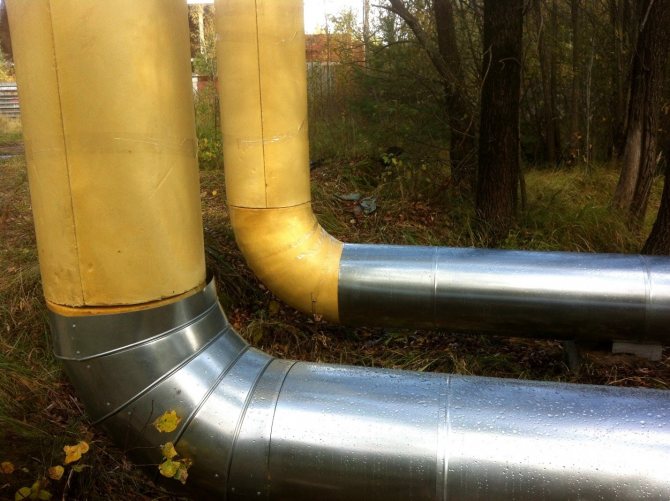

Galvanized insulation is applied to gas pipes
The galvanized casing is used to protect and insulate chimneys, exhaust gas pipes in private houses. Also used for pipelines in the oil industry.
The zinc casing is an indispensable item for covering the surface of heating mains. It not only protects the metal from destruction, but also reduces heat loss.
The advantages of galvanized insulation:
- attractive appearance;
- easy installation;
- durability.
In the chemical industry, a zinc cover is used to protect workers from accidental contact with hot surfaces that could cause injury to people.
Structures and types of fittings
Utilities networks have a complex spatial configuration, include shut-off - control and control - measuring valves. Therefore, to insulate such structures, not only straight sections are needed, but also various shaped elements: tees, bends, transitions, plugs, etc.
Straight section
It is a ready-to-install product in the form of an open cylinder. It is mounted with an overlap with other segments, fastened with locks - latches, screws or rivets.


The main standard sizes of straight sections of shells:
- length - from 470 mm to 1000 mm;
- outer diameter - from 60 mm to 500 mm (in 10 mm increments), from 90 mm to 1000 mm (in 10 mm increments);
- holes for fasteners - 4-6 pcs. with a diameter of 2.7 mm for self-tapping screws or in the amount of 3-6 pcs. with a diameter of 3.2 mm for rivets or latches.
Diversion
Elbows - parts made of galvanized steel 0.55 thick; 0.7; 1.0 mm with a bend radius of 90 or 45 degrees. They are used in places where the pipeline changes direction to protect the thermal insulation of shaped elements.
Tee
Tees protect the branch points of the pipe network. Available in several versions:
- round T-shaped 90 degrees;
- straight with the same length of pipes;
- with a shortened shoulder length at 30 and 45 degrees.
They are installed in the same way as straight-line products with an overlap, fastened to self-tapping screws for metal (such as bugs) or rivets.
End cap / transition
End caps - designed to protect the heat-insulating layer at the end of pipelines. Consist of two parts with zigzags, mounting holes and self-tapping screws.
A transition is a straight, concentric or eccentric shell section, ready for installation. It has one longitudinal and two transverse ridge, holes for fasteners and the required number of self-tapping screws. It protects fittings installed at the junction of pipes of different diameters or made of different materials.
Zeppelins
Zeppelins are circular shaped pieces made up of segments (petals).
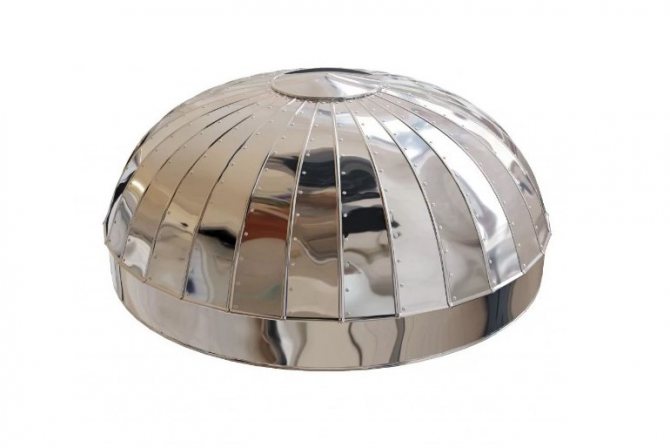

Ridges and holes for rivets (self-tapping screws) are provided along the edge of each segment. Zeppelins are used to insulate the ends of tanks and tanks.
Shells for valves and flanges
They are made in the form of a detachable box with the necessary zigs and special locks - latches, for rigid and reliable fixation of parts of the product. They serve as protection of the heat-insulating layer from the negative effects of the environment at the locations of shut-off devices, various instrumentation, flange connections of the pipeline system.
Cones
Tapered casings are a type of galvanized coating of a tapered shape with longitudinal and transverse ridges. They perform the function of protecting the thermal insulation layer on the end surfaces of tanks, on chimney pipes and ventilation outlets from the street side.
Sidebars
A shell for a tie-in is a straight line segment with longitudinal and transverse ridges and a curved abutment for mating with the main insulation element, holes for fasteners and the required number of self-tapping screws. It is used to protect the insulation layer at the points of abutment (branching) of lines from the main pipeline.
VUS and CPP insulation
VUS insulation, outdated names LEAD-1 and Selmers... Distinguish between insulation US, VUS-2 (VUS two-layer) and VUS-3 (VUS three-layer). The operation of steel pipes, bends, tees, transitions made of carbon and low-alloy steels in VUS insulation allows increasing the reliability and extending the service life of underground pipelines, reducing the cost of their technical operation. Steel pipes with an outer two-layer or three-layer anti-corrosion coating of VUS made of extruded polyethylene are used for gas pipelines transporting natural gas (main and distribution pipelines), oil pipelines, water pipelines, heating network pipelines, piles and other steel underground structures. VUS insulation effectively protects against: - atmospheric corrosion (in areas where underground structures exit from the ground); - corrosion in soil and ground waters and grounds; - biocorrosion; - corrosion caused by stray and induced currents. Pipelines in VES insulation are capable of trouble-free service for 30 years even in aggressive environments.
Multi-layer extruded polyethylene coating provides:
- extremely low water absorption;
- water permeability;
- increased adhesion between insulating material and metal;
- reliable external corrosion protection of pipelines.
Due to these characteristics, VUS pipes are capable of trouble-free service for more than 30 years, even under the influence of an external aggressive environment.


An example of a symbol for a steel pipe with a diameter of 159 mm, with a wall thickness of 4.5 mm in insulation and VUS: Pipe st. 159x4.5 VUS.
GOST 9.602-2005, Table 6
Design of protective coatings for structures under construction and reconstruction
Coating conditions | Construction number | The design (structure) of the protective coating | Protective coating thickness, mm, not less | Pipe diameter, mm | Maximum operating temperature, ˚С |
Protective coatings of a highly reinforced type | |||||
| Factory or basic | 1 | Three-layer polymer: - primer based on thermosetting resins; - hot melt polymer sublayer; - a protective layer based on extruded polyethylene. Two-layer polymer: - hot-melt polymer sublayer; - a protective layer based on extruded polyethylene. | 2,2 2,5 3,0 3,5 3,5 | 57 to 89 incl. "102" 259 "" 273 "426" "530" 820 "St. 820 | 60 |
| 2 | Two-layer polymer: - hot-melt polymer sublayer; - a protective layer based on extruded polypropylene. | 2,0 2,2 2,5 2,5 | 219 to 259 incl. "259" 426 "" 530 "820" St. 820 | 60 | |
| 3 | Combined on the basis of polyethylene tape and extruded polyethylene: - polymer primer; - polyethylene tape with a sticky layer at least 0.45 mm thick (in one layer); - a protective layer based on extruded polyethylene. | 2.2 2.5 3.0 | 57 to 114 incl. "133" 259 "" 273 "530" | 40 | |
| Basic | 4 | Polymer tape: - polymer primer; - insulating tape with a sticky layer at least 0.45 mm thick; protective wrap with a sticky layer at least 0.6 mm thick (in one layer). | 1,8 | 57 to 530 inclusive | 40 |
| Piste | 5 | Polymer-bitumen tape: - bitumen or bitumen-polymer primer; - polymer-bitumen tape with a thickness of at least 2.0 mm (in two layers); - protective polymer wrap with a sticky layer, at least 0.6 mm thick, | 4,0 4,6 | 57 to 159 incl. "168" 1020 " | 40 |
| Basic and route | 6 | Tape polymer-bitumen or polymer-asmol: - bitumen or asmol primer; - polymer-bitumen or polymer-asmol tape with a thickness of at least 2.0 mm (in one layer); - polymer wrap with a thickness of at least 0.6 mm, with a sticky layer. | 2,6 3,2 | From 57 to 114 inclusive "133" 426 " | 40 |
| Basic | 7 | Mastic: - bituminous or bitumen-polymer primer; - insulating bitumen or bitumen-polymer mastic, or based on asphalt-resinous oligomers, reinforced with two layers of glass fiber; - kraft paper overwrap layer | 7,5 9,0 | 57 to 159 incl. "168" 1020 " | 40 |
| 8 | Combined on the basis of mastic and extruded polyethylene: - bitumen or bitumen-polymer primer; - modified bitumen-polymer mastic with a thickness of 1.5 to 2.0 mm; - a protective layer based on extruded polyethylene. | 3,3 4,0 | 57 to 159 incl. "168" 426 " | 40 | |
| Basic and route | 9 | Based on heat-shrinkable tapes with hot-melt adhesive (one layer). | 1,85) 2,0 2,2 | 57 to 259 incl. "273" 426 "St. 426 | 60 |
| Piste | 10 | Based on heat-shrinkable materials with a mastic-polymer adhesive layer | 2,3 2,8 | 57 to 426 incl. "530" 820 " | 40 |
Reinforced type protective coatings | |||||
| Factory or basic | 11 | Three-layer polymer: - primer based on thermosetting resins; - hot melt polymer sublayer; - a protective layer based on extruded polyethylene. Two-layer polymer: - hot-melt polymer sublayer; - a protective layer based on extruded polyethylene. | 1,8 2,0 2,2 2,5 | 57 to 114 incl. "133" 259 "" 273 "530" "630" 820 " | 60 |
| Factory or basic | 12 | Combined on the basis of polyethylene tape and extruded polyethylene: - polymer primer; - polyethylene tape with a sticky layer at least 0.45 mm thick (in one layer); - a protective layer based on extruded polyethylene. | 2,2 2,5 | 57 to 273 incl. "325" 530 " | 40 |
| Basic | 13 | Mastic: - bituminous or bitumen-polymer primer; - insulating bitumen or bitumen-polymer mastic, or based on asphalt-resinous oligomers, reinforced with two layers of glass fiber; - a layer of the outer wrapping made of rolled materials with a thickness of at least 0.6 mm. | 6,0 | 57 to 820 incl. | 40 |
| Factory or basic | 14 | Silicate-enamel (in two layers) | 0,4 | 57 to 426 incl. | 150 |
| 15 | Based on epoxy paints | 0,35 | 57 to 820 incl. | 80 | |
| 16 | Based on polyurethane resins | 1,5 2,0 | 57 to 273 incl. "325" 1020 " | 60 | |
Polymer-bitumen tape
Polymer-bitumen tape (PIRMA, LITKOR) is used to protect against corrosion of steel underground pipelines for various purposes, including city water pipelines and main gas and oil pipelines. The tape is used in constructions of protective coatings No. 5 and 6 in accordance with GOST 9.602-2005. Polymer-bitumen tape is a versatile material for insulating joints of gas pipelines, as well as fittings, turning angles and repairing damaged areas of mastic bitumen coatings and coatings made of extruded polyethylene (pipelines in VUS insulation).
MAIN CHARACTERISTICS
| Name | Norm |
| Total tape thickness, mm, not less | 1,8 |
| Belt web width, mm ** | 450 |
| Cloth length in a roll, m, not less | 60 |
| Roll outer diameter, mm, up to | 400 |
| Tape area per roll at width | 450mm - 27 sq.m. |
| Weight 1 sq.m | 1.85 kg |
| Weight of 1 roll | 50 Kg |
** - By agreement with the consumer, it is possible to manufacture a tape of a different width and length of the web and a different outer diameter of the roll.
Polymer-bitumen tape "LITKOR-NK-GAZ", TU 5774-009-32989231-2011, TU 2245-019-05801845-2006 instead of TU 2245-019-05801845-2004, It is intended in the construction of the coating as a wrapper, when carrying out overhaul of the insulating coating (re-insulation) of gas pipelines with a diameter of up to 820 mm inclusively, when the temperature of the transported product does not exceed +35 C.
| P / p No. | Indicator name and units | Norm | Method of determination |
| 1. | Roll appearance | Smooth edges.Taper, barrel, saddle is allowed, but not more than 5 mm in the width of the roll | clause 5.1 of these TU |
| 2. | Appearance of the tape | Skips of mastic and foreign inclusions are not allowed | clause 5.1 of these TU |
| 3. | Flexibility on a beam with a radius of curvature of 10 mm, оС, not higher | — 20 | According to GOST 2678, according to clause 5.7 TU |
| 4. | Adhesion to polymer-bitumen coating at a temperature of + 23 ± 2 оС, N / cm, not less | 10,0 | GOST 411 Method B. According to clause 5.8 TU |
| 5. | Adhesion of tape to tape in overlap at a temperature of + 23 ± 2 оС, N / cm, not less | 7,0 | GOST 411 Method B. According to clause 5.8 TU |
| 6. | Water absorption after 1000 hours of exposure in water at a temperature of + 60 ± 2 ° C,%, no more | 5 | According to GOST 4650, according to clause 5.9 of TU |
| 7. | Resistance to fungi, point, no more | 2 | GOST 9.048-9.049, According to clause 5.10 TU |
| 8. | Strength at break of the base tape in the longitudinal direction at a temperature of + 23 ± 2 оС, MPa, not less | 12,0 | GOST 11262-80, According to clause 5.11 of TU |
| 9. | Elongation at break of the base tape in the longitudinal direction at a temperature of + 23 ± 2 оС,%, not less | 200 | GOST 11262-80, According to clause 5.11 of TU |
| 10. | Thickness, not less, mm | 1,8±0,2 | |
| 11. | Web width, mm | 450±5 | |
| 12. | Roll diameter, mm | 400±10 | |
| 13. | Winding length in a roll, not less, m | 60 |
Cement-sand mortar insulation is applied to the inner surface of steel pipes, elbows, reducers and tees using a high pressure centrifugal pump. After application, the mixture is smoothed and dried. As a result, a smooth surface is formed that does not obstruct the throughput of water supply networks. This method is reliable, cost-effective due to the low cost of raw materials (cement, sand) and can be used for almost any pipe diameter. Cement-sand insulation provides a full anti-corrosion (active and passive) protective effect of the inner surface of the walls of pipes and fittings. The active effect of protection is based on the creation of increased corrosion resistance due to the alkaline reaction of the cement mortar, the passive effect is based on the creation of a high degree of compaction and strength of the coating. Along with this, the CPI prevents the formation of internal deposits and fouling of pipes with a slippery layer and build-ups, which increases the operational capabilities of water supply systems.
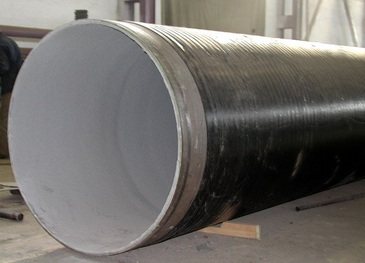

An example of a conventional designation of a steel pipe with a diameter of 219mm, with a wall thickness of 6.0mm, with CPP insulation: Pipe st. 219x6.0 CPP.
An example of a conventional designation for a steel pipe with a diameter of 377 mm, with a wall thickness of 8.0 mm, with VUS-2 and CPP insulation: Pipe st. 377х8.0 VUS CPP.
An example of a symbol for a steel branch with a diameter of 108 mm, a wall thickness of 4 mm, a bend angle of 90 g in VUS and CPP insulation: Branch of art. 108x4.0-90gr VUS CPP.
approximate cost
The approximate cost of straight sections of galvanized steel enclosures is shown in the table.
| Outside diameter | Price per piece, in rubles |
| Ø 100 | 180 |
| Ø 125 | 230 |
| Ø 160 | 300 |
| Ø 200 | 370 |
| Ø 250 | 460 |
| Ø 315 | 565 |
| Ø 400 | 880 |
| Ø 450 | 992 |
| Ø 500 | 1110 |
| Ø 560 | 1225 |
| Ø 630 | 1378 |
| Ø 710 | 1686 |
| Ø 800 | 2058 |
| Ø 1000 | 2572 |
| Ø 1250 | 3200 |
Scope of application and installation features
Galvanized steel casings have high performance characteristics and an affordable price, therefore they are widely used in:
- hot and cold water supply systems
- sewer mains;
- oil and gas pipelines;
- thermal lines laid underground, in trenches, by ground method;
- ventilation systems;
- arrangement of stoves, fireplaces (insulation of chimneys);
- fire-fighting water supply systems;
- systems of supply and discharge pipelines with circulating process fluid;
- to protect the open working bodies of machines and mechanisms.
The process of installing a galvanized shell is quite simple, does not require the use of special technological equipment and is easy to do with your own hands.
Non-professionals can use the following step-by-step instructions for isolating a separate section in an already operating highway:
- clean the surface of the required section of the pipeline from dirt;
- degrease it white - with alcohol or solvent;
- apply a bituminous primer to the surface of the working pipes;
- remove moistened parts of polyurethane foam insulation at the ends of adjacent pipe sections;
- heat up the protective shell at the junction to a temperature of about 80 ° C - a special adhesive tape (bitumen-rubber MBR) is laid on this place;
- fix the protective galvanized shell at the junction, securing the product with special clamps or cuffs;
- drill several holes for pouring polyurethane foam;
- mix the foaming agent and pour it into the prepared holes;
- seal the holes with Abris sealing tape.
The main condition is that the installation must be carried out at an ambient temperature of at least + 20 ° C and in dry weather.
In rainy weather, the network should be laid under a canopy or in another type of shelter, otherwise moisture may penetrate in the form of condensation or precipitation into the inner layer of insulation.
Insulation of pipes
Today, when energy prices are steadily increasing, reducing heat loss has become one of the important points of savings. Insulation of pipes with modern high-quality materials fully meets these requirements.
Thermal insulation of pipelines can significantly reduce not only heat loss in the system, but also prevent the occurrence of other problems. The solution to this kind of problems can be technologically competent insulation of PVC.
Most of the modern materials used for the insulation of communications are attracted by the low cost of installation work, the high speed of their implementation and reliability. Thermal insulation of pipelines is carried out using materials based on foamed rubber (K-Flex pipe insulation), or polyethylene, in some cases - with an additional aluminum coating.

